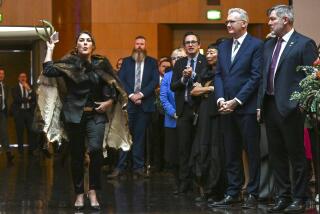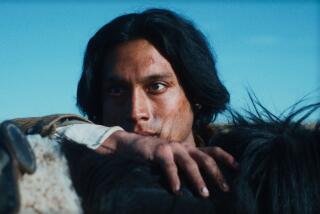Australia Comes to Grips With Slave History : Discrimination: Novelist’s book recalls the traders who plundered South Pacific islands.
- Share via
SYDNEY, Australia — Shackled, flogged with kangaroo hide whips and raped at will, Australia’s slaves died by the thousands.
Between 1842 and 1904 more than 60,000 men and boys from the South Pacific islands, and an unknown number of women and girls, were kidnaped and brought to Australia to work as slaves on the sugar plantations that still dot the country’s northeast coast.
But their screams were ignored by the country’s white historians, and 150 years later few Australians are aware of this brutal period of their history.
Today the descendants of these slaves are fighting for recognition as a race and for help from the Australian government in overcoming both white and black racism.
“They don’t know who they are, they are a people who have fallen through the cracks,” says Faith Bandler, the daughter of a slave.
“There is an element of loss. They are caught between two worlds,” she said.
Bandler’s father, Wacvie Mussingkon, was kidnaped in 1883 at age 13 from the island of Ambrym in what is now Vanuatu.
“He grew to manhood in the gentle rhythms of an island village . . . but his life ended in the few moments that it takes to shackle a man,” wrote Bandler in a novel about her father called “Wacvie.”
In what was called “blackbirding,” slave traders plundered the coral-fringed islands of the South Pacific for their human cargo.
Traders lured islanders out to their tall ships with trinkets, and they were lassoed, dragged on board and chained together for the four-month journey. Many never saw Australia, dying from a host of diseases and their bodies tossed overboard.
“The Pacific paradise became a place of terror and fear,” wrote author Hector Holthouse in “Cannibal Cargoes” in 1969.
Blackbirding was a means of meeting the needs of cheap labor that arose with the end of convict transportation from Britain.
The first slaves to reach Australia were used as shepherds on properties in southern New South Wales but died from the cold.
When the American Civil War cut off the world’s cotton supply, Australian slaves were used to establish cotton plantations in southern Queensland. But by the 1860s the country’s fledgling sugar industry was the main slave market.
A strong male would cost the modern equivalent of between $5 and $19, while women, particularly Tahitians, who were regarded as the most attractive, often fetched $32.
Bandler’s father fetched top prices on the sugar plantations near Mackay, on the Queensland coast, until his escape in 1897.
Wacvie strove to keep his island culture alive and Bandler still vividly remembers the stories he told her as a child.
The life of a slave on an Australian sugar plantation was little different from that on the American cotton plantations. Brutality and deprivation were the daily ritual, Bandler says.
In 1901, under pressure from the British anti-slavery movement, the newly formed Australian government banned slavery and ordered islanders to be repatriated. But some ship captains took their human cargoes well offshore and threw them overboard.
The end of slavery in Australia did not mean the end of discrimination against the islanders who remained.
Unions banned them from working on European farms, the only work they were trained for, and the color of their skin condemned them to the racism being meted out to the country’s aborigines.
In 1967, aborigines and Torres Strait islanders were granted the vote and many welfare benefits, such as subsidized housing, education and employment, but South Sea islanders were ignored.
A 1977 Royal Commission Into Human Relationships in Australia called this discrimination. “The South Sea Islanders are not eligible for these benefits unless they claim to be aboriginals, a claim which many feel is a denial of their own origin,” the commission said. It recommended that the government take immediate action to rectify the situation.
But after almost 15 years of inaction, South Sea islanders, led by Bandler, have now launched a campaign for justice.
As vice president of the Evatt Foundation, a nonprofit research institute, Bandler oversaw a report into the history and plight of the 15,000 to 20,000 descendants of slaves living in Australia, mainly along the Queensland coast.
The report published in September called on the Australian government to immediately recognize South Sea islanders as a race and help them overcome discrimination.
“Australian South Sea islanders are a black minority group who have been and are discriminated against because of their color--a lost race with little trace of their culture and languages.”
Bandler says South Sea islanders do not want land rights, merely recognition that they exist and equal opportunities to survive in Australia.
The creation this year of a new aboriginal affairs administrative body run by aborigines has led to black racism towards South Sea islanders, making reform urgent, Bandler says.
“Being black makes you very conscious whenever white racism is around--but there is nothing as vicious as black racism,” she says.
More to Read
Sign up for Essential California
The most important California stories and recommendations in your inbox every morning.
You may occasionally receive promotional content from the Los Angeles Times.













